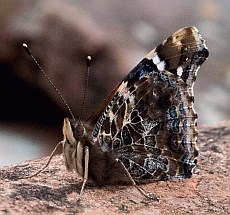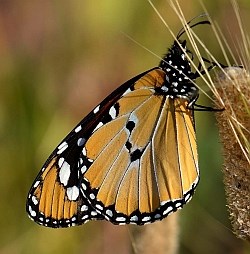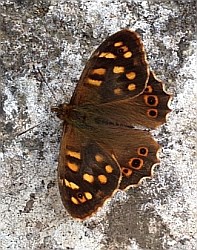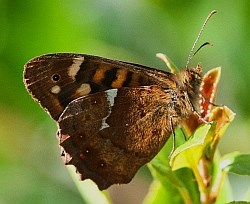Butterflies seen on Teresa's recent Canaries trip
Teresa Farino
19/04/2014 09:31:16
Teresa's Butterfly Conservation Donation Scheme got off to a splendid start in the Western Canaries in March, with 17 species seen during the week.
Posted in: Butterflies and Moths, Endangered Wildlife and Habitats | Canary Islands | Spanish Islands
@Gonepteryx cleobule.jpg) Canary Brimstone (male)
Canary Brimstone (male)
Gonepteryx cleobule© Ken BaileySeventeen species of butterflies might not sound like a lot, but Tenerife and La Gomera are known to harbour only approximately 30 species of butterfly (depending on which taxonomic scheme one uses) between them. Of these, some are very much high-summer insects, so we did not expect to see species such as Meadow Brown, Gomera and Canary Graylings, Tenerife Green-striped White (which is a high-altitude representative of this group) or the endemic race of Cardinal (seitzi). It also seemed that we were a bit early for the Canary Skipper (which I have still never seen, despite visiting these islands in every month of the year!). However, despite some rather unfavourable weather at times, of the Canary endemic species on offer at this time of year, we only missed out on the La Gomera Brimstone.
@Pieris cheiranthi cheiranthi.jpg) Canary Islands Large White (female)
Canary Islands Large White (female)
Pieris cheiranthi cheiranthi© Ken BaileyOur visit to one of the barrancos in north-western Tenerife was perhaps the butterfly highlight of the tour, turning up – as expected – the endemic and endangered Canary Islands Large White (Pieris cheiranthi cheiranthi) and Canary Brimstone (Gonepteryx cleobule), as well as abundant Canary Speckled Woods (Pararge xiphioides) and Canary Red Admiral (Vanessa vulcania).  Canary Red Admiral
Canary Red Admiral
Vanessa vulcania.© Dan LogenOne additional point of interest here was that we found Canary Islands Large White caterpillars feeding on the crucifer Descurainia millefolia, which was unusual, as their habitual foodplant is generally regarded as being various Crambe spp. It does, however, confirm what Teresa had suspected, having seen female Canary Islands Large Whites ovipositing on D. millefolia on both Tenerife and La Palma in 2013.
The fact that the road to Teno was physically blocked off to traffic this year meant that we had to find a similar coastal habitat with abundant Lotus species for the endemic Canary Blue (Cyclirius webbianus), which we managed close to Buenavista, although the stiff breeze meant that photographing @Cyclirius webbianus.jpg) Canary Blue (male)
Canary Blue (male)
Cyclirius webbianus© Dan Logenthese diminutive butterflies was not easy. Here too we tracked down Long-tailed Blue (Lampides boeticus) and African Grass Blue ( Zizeeria knysna), as well as Small Copper (Lycaena phlaeas), all of which were seen on several occasions in lowland habitats on both islands.
@Zizeeria knysna.jpg) African Grass Blue (ovipositing)
African Grass Blue (ovipositing)
Zizeeria knysna© Steve PettyOther species that turned up habitually and in some abundance in most low-level habitats we visited during the week were Painted Lady (Vanessa cardui), Clouded Yellow (Colias crocea), Bath White (Pontia daplidice) and Small White (Pieris rapae), although we managed to miss out on Lang's Short-tailed Blue and Spanish Brown Argus.
@Captopsilia florella.jpg) African Migrant (male)
African Migrant (male)
Captopsilia florella© Di HallOur visit to the botanical garden in Icod de los Vinos – normally a guaranteed location for Monarch (Danaus plexippus) – coincided with rather cold and cloudy conditions, so we managed only a fleeting glimpse of a single individual of this species as a brief break in the clouds allowed a ray of sun hit the top of the millennial Dragon-tree that is the focal point of this garden.
@Captopsilia florella.jpg) African Migrant (female)
African Migrant (female)
Captopsilia florella© Steve PettyOn La Gomera, Teresa’s insistence that the group visit the park in San Sebastián in search of better views of Monarch (while she picked up some lunch supplies) was fortuitous indeed, as nearly everyone managed to get photos of both male and female African Migrants (Catopsilia florella), although unfortunately there was no trace of the Monarchs that habitually occur there. We later observed eggs of African Migrant on a roadside stand of African Senna (Cassia didymobotrya).
 Plain Tiger
Plain Tiger
Danaus chrysippus.© Ken BaileyThe botanical garden at Juego de Bolas added Geranium Bronze (Cacyreus marshalli) to our list, while a last-minute visit to a small flowery lay-by on the road to Hermigua turned up what was very much the surprise of the trip: no less than three Plain Tigers (Danaus chrysippus), one of which was in pristine condition. The only possible food plant (Asclepiadaceae) for the species growing here was some stands of Periploca laevigata.
 Canary Speckled Wood
Canary Speckled Wood
Parage xiphioides.© Di HallThis brought our final total for the trip to seventeen species, raising a total of £51 for Butterfly Conservation: an excellent start to the scheme, as several of these butterflies are Canary Island endemics and therefore will not be seen on any of Teresa’s other wildlife holidays this year.
The participants on this Canary Islands tour – Dan Logen, Di Hall, John Winterbottom, Ken Bailey and Steve and Linda Petty – were all very keen butterfly enthusiasts and were able to get some lovely photographs between them, some of which are reproduced on this page. Many thanks to you all!
 Canary Speckled Wood
Canary Speckled Wood
Parage xiphioides© Dan Logen
Related information
Spring in the Western Canaries
Read more blog posts